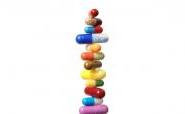
Featured article
A guide to weight loss options in a capsule

We all know in theory the healthy ways to a slimmer body. Reportedly, the best diet to follow is the low GI diet. Low Glycaemic Index foods trickle carbohydrates gradually into your blood sugar levels so digestion is slower and you feel fuller for longer. In other words, eat one type of food and you put on more weight, eat another and you don’t. You could even follow Patrick Holford’s GL diet which calculates the quality and quantify of your food for you.
But as we know, changing your way of eating is ground-breaking stuff, involving an overhaul of your fridge and cupboards, forward planning and the avoiding of buffet restaurants. Slimming pills are like a promise in a bottle. Wouldn’t it just be easier to pop a pill and hope for the best? While there are some pills in the form of supplements which help you lose weight and keep it off, there are others which are not ideal for your health, and we’ll look at these in this article.
Fat-binding pills
Fat-binding pills do as they say on the box; the ingredients bind to the fat in your food which passes out of your body without being digested or extracted as normal. With such pills you must stick to a low-fat and low-sugar diet. The main ingredient in many of these is Orlistat, whose side effects include diarrhoea, especially if you’ve consumed too much fat in your meal. Chitosan, another fat-binding ingredient derived from crustacean shells, can be effective in reducing body’s fat absorption from food, although its quality and therefore effectiveness can vary.
article continued
Advertisement
The problem with these types of pills is that they do not differentiate between good fats and bad fats. Eating fish or dairy while popping these pills could mean your body is deprived of the good fats from these foods, which would have a knock-on effect on your digestion, your body cells and ultimately your skin, hair and nails. Secondly, they are messing up your body’s normal process. Our digestive systems were made to take out the goodness and nutrients from food and discard the waste, not to select and discard a whole food group.
Lastly, and most importantly, you still have to change your food lifestyle. Some pills on the market, especially those on prescription, are time limited. Once your 6 months or so are up, you are on your own and if you haven’t changed your eating habits by then because you’ve been relying solely on the pills, you’re likely to regain all the weight.
Bulking pills
Bulking pills work by bulking your stomach so that you feel full. They need to be taken several times a day, usually before meals and snacks. They normally contain a type of fibre which absorbs the water that you take in and swells; a side effect will be bloating and swelling and, especially if you don’t drink enough water, excess gas. (A positive side effect from this could be that you forego the lift in favour of the stairs!)
Though this can work (it did with the son of a friend of mine), the trouble is that adults don’t always recognize the feeling full signals from the stomach to the brain. How often have you felt stuffed but still able to manage one tiny dessert?
Vitamin supplements
An alternative to slimming pills is to pop vitamin supplements; as your diet changes, ideally to low-GL, the supplements are there to give an extra boost. When going down the supplement route you should ideally start with a good multi-vitamin/multi-mineral and then add to that if you need to. Chances are, the vitamin or mineral you need may already be in that supplement and you just add extra if you need to increase the dosage of that particular one.
Chromium helps insulin to work more efficiently in lowering your blood sugar. This is particularly important if you have type 2 diabetes as you are likely to be chromium deficient. Natural food sources are liver, brewer’s yeast and wheatgerm. Chromium picolinate is useful for weight loss as it helps your body to hang onto the muscle while shedding fat. It’s also thought that chromium helps you control cravings as it affects brain signals that indicate your hunger. In studies, people who took chromium ate less and felt less hungry.
It has been found that taking vitamin C and calcium reduce the likelihood of gaining fat around the middle. Vitamin C reduces fat absorption and the fibre and water in vitamin C-rich foods help with weight loss. Low vitamin C is associated with increased body fat and larger waist measurements.
Calcium, especially that contained in dairy foods, slows down the body’s ability to make fat. It is believed that calcium in fat cells changes how the fat is stored and used. Calcium from either supplements or a high calcium diet will produce fat burning results, but the best would be from dairy foods!
HCA extracted from tamarind slows down the rate at which sugar is converted into fat. It also stimulates the satiety centre in the brain, the part which tells the brain that you are full but this has no side effects.
CLA (Conjugated Linoleic Acid) from safflower oil (omega 6) helps to increase lean muscle tissue which, in turn helps to burn fat. CLA itself also lowers body fat because of its effect on lipoprotein lipase which stores fat in the body.
Whichever pill you take, in isolation you won’t get the long-term results you want unless you also change your eating habits and your lifestyle.